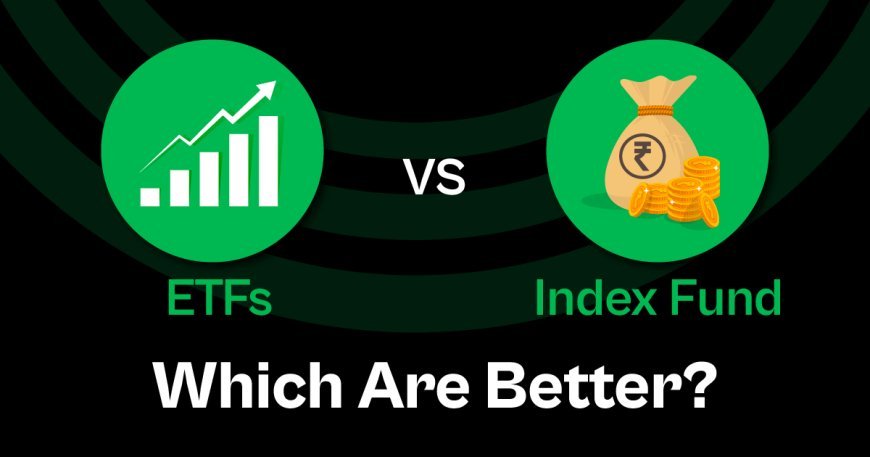Index Funds vs. ETFs: Which Is Better for New Investors?
This article compares index funds and ETFs for new investors, detailing their differences in trading, costs, minimum investments, tax efficiency, and automation. Index funds suit hands-off investors with automated investing options, while ETFs offer flexibility and lower entry costs. The choice depends on budget, goals, and trading preferences, with both being low-cost, diversified options.

For new investors, choosing the right investment vehicle can feel overwhelming. Two popular options—index funds and exchange-traded funds (ETFs)—offer low-cost, diversified ways to enter the market. But which is better for someone just starting out? This article breaks down the key differences, advantages, and considerations to help new investors decide.
What Are Index Funds and ETFs?
Index Funds are mutual funds designed to track the performance of a specific market index, like the S&P 500. They pool money from investors to buy a portfolio of stocks or bonds that mirror the index’s components, aiming to replicate its returns.
ETFs (Exchange-Traded Funds) also track indices but trade like stocks on an exchange. They hold similar diversified portfolios but allow investors to buy and sell shares throughout the trading day at market prices.
Both options provide diversification, low costs compared to actively managed funds, and exposure to broad market performance, making them attractive for beginners.
Key Differences
1. Trading and Flexibility
- Index Funds: Purchased directly from a fund provider, typically at the end of the trading day at the net asset value (NAV) price. They’re ideal for investors who prefer a “set it and forget it” approach.
- ETFs: Trade on stock exchanges, allowing intraday buying and selling at fluctuating market prices. This flexibility suits investors who want more control or may want to react to market movements.
2. Minimum Investment
- Index Funds: Often have minimum investment requirements, sometimes $500–$3,000, depending on the fund provider. However, some brokers now offer fractional shares or no minimums.
- ETFs: No minimum investment beyond the price of a single share, which can be as low as $10–$100 for popular ETFs. This makes ETFs more accessible for those with limited capital.
3. Costs
- Index Funds: Typically have low expense ratios (e.g., 0.03%–0.2%), but some may charge sales fees (loads) or transaction fees, especially if purchased through a broker.
- ETFs: Also have low expense ratios, often comparable to or lower than index funds. However, because they trade like stocks, investors may incur brokerage commissions or bid-ask spreads, though many platforms now offer commission-free trading.
4. Tax Efficiency
- Index Funds: Generally tax-efficient due to low turnover, but they may distribute capital gains annually, which can trigger taxes in taxable accounts.
- ETFs: Often more tax-efficient due to their structure, which allows in-kind redemptions, minimizing capital gains distributions.
5. Automatic Investing
- Index Funds: Support automatic investment plans, allowing investors to set up regular contributions (e.g., monthly deposits). This is great for building wealth gradually.
- ETFs: Typically don’t offer automatic investment options, requiring manual purchases, which may disrupt consistent investing habits for beginners.
Advantages for New Investors
Index Funds
- Simplicity: Easy to understand and manage, especially for those who want a hands-off approach.
- Dollar-Cost Averaging: Automatic investment plans make it easy to invest fixed amounts regularly, reducing the impact of market volatility.
- No Trading Knowledge Needed: No need to worry about market timing or bid-ask spreads.
ETFs
- Low Entry Barrier: Affordable share prices make ETFs accessible for small portfolios.
- Flexibility: Intraday trading allows investors to take advantage of price movements or rebalance quickly.
- Broad Options: ETFs cover niche sectors, commodities, or international markets, offering more variety for adventurous beginners.
Considerations for New Investors
- Investment Goals: If you’re focused on long-term growth and want to automate your investments, index funds may be better. If you prefer flexibility or want to start with a small amount, ETFs are a strong choice.
- Costs: Compare expense ratios and fees. For example, Vanguard’s S&P 500 ETF (VOO) has an expense ratio of 0.03%, while its index fund equivalent (VFIAX) is 0.04%. Small differences can add up over time.
- Platform: Many brokers, like Fidelity or Schwab, offer commission-free ETFs and low- or no-minimum index funds, leveling the playing field.
- Tax Situation: In taxable accounts, ETFs may save on taxes, but in tax-advantaged accounts (e.g., IRAs), this matters less.
Which Is Better?
There’s no one-size-fits-all answer. Index funds are often better for new investors who value simplicity, automation, and a long-term, hands-off strategy. They’re ideal for retirement accounts or those starting with regular contributions. ETFs suit investors with smaller starting budgets, those who want trading flexibility, or those interested in niche markets.
A practical approach is to start with index funds for core investments (e.g., an S&P 500 index fund) and use ETFs to diversify into specific sectors as you gain confidence. Regardless of your choice, focus on low-cost, broad-market funds to keep fees minimal and diversification high.
Conclusion
Both index funds and ETFs are excellent starting points for new investors, offering low costs and broad market exposure. Your choice depends on your budget, investment style, and whether you prioritize automation or flexibility. Research specific funds, compare fees, and consider your financial goals to make an informed decision. The most important step is to start investing early and stay consistent—either option can set you on the path to long-term wealth.
What's Your Reaction?
 Like
0
Like
0
 Dislike
0
Dislike
0
 Love
0
Love
0
 Funny
0
Funny
0
 Angry
0
Angry
0
 Sad
0
Sad
0
 Wow
0
Wow
0













